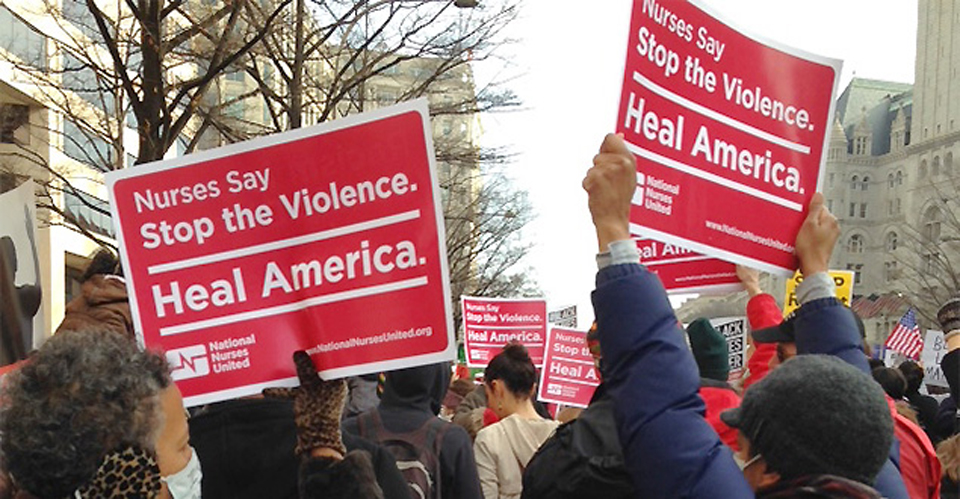
WASHINGTON—By a bipartisan 251-158 vote, the Democratic-run House passed HR1309, ordering hospitals and nursing homes – via the Occupational Safety and Health Administration – to create and enforce plans to protect their workers, especially nurses, from violent and sometimes deadly attacks by patients or their families.
But the measure, pushed for seven years by National Nurses United, with the aid of the Teachers (AFT), AFSCME, the AFL-CIO, the Steelworkers, the Machinists and other unions, faces two big Republican roadblocks.
One is Senate Majority Leader Mitch McConnell, who has pigeonholed 300 pieces of House-passed progressive legislation. If he deep-sixes this one, it would be #301.
The other is GOP President Donald Trump, whose Office of Management and Budget is urging him to veto the bill – which is just what the special interests and the 157 House Republicans who opposed it want.
NNU and its backers, led by union co-president Zenei Cortez of California, AFL-CIO Secretary-Treasurer Liz Shuler, Teachers President Randi Weingarten, House sponsor Joe Courtney, D-Conn., and Senate sponsor Tammy Baldwin, D-Wis., celebrated the vote at an outdoor Capitol Hill press conference on Nov. 21.
“This is literally a life or death issue for our nurses, who are constantly at risk of violence in their workplaces. Every moment we wait to pass this bill into law puts lives in jeopardy,” Cortez said.
Baldwin, looking ahead, also urged participants to lobby their senators, hard, and to cite the bipartisan vote – 21 Republicans broke party ranks to vote for the measure – as a reason to get it through the Senate, too.
“Seventy percent of nurses and social workers suffer workplace assaults,” Shuler said. In one example, “I met with Alicia Shin, an acute care nurse from Los Angeles. A violent patient pulled out his IVs, then kicked her in the chest and in the face.”
If other nurses hadn’t rushed in to help, Shuler said, there’s no telling what would have happened to Shin. She couldn’t return to work for weeks, and still suffers flashbacks.
Shin’s not alone. One speaker noted violent patients or their family members kill some 80 nurses or social workers and injure thousands more every year, while a nonpartisan federal report puts the yearly death toll for nurses alone at 58. Yet health care facilities do little or nothing to provide security and safe workplaces.
“Workplace violence is an epidemic” nationwide, except – now — in California, said Cortez, a California Nurses Association member. There, CNA/NNU pushed a strong anti-violence law through the state legislature three years ago. Its strength is one reason Trump’s advisors want him to veto HR1309. They said California standards should not be imposed on the rest of the U.S., and claimed those standards could actually harm workers, without citing any evidence.
Baldwin, Cortez, Courtney, Shuler, Weingarten and other speakers disputed Trump’s view and supported the legislation.
“Energized health care and social services workers should enjoy a safe and violence-free workplace,” Baldwin declared as a crowd of NNU members flanked her, holding distinctive red-and-white signs supporting the legislation.
“We all rely on people in these professions,” health care and social work, “to take care of us,” Courtney said. “It’s important we take care of them.”
“OSHA agreed to do a rulemaking on workplace violence,” ordering the health care facilities to enact and enforce those anti-violence plans, she noted. “But then it stalled under Trump.”
NNU sought the start of rule-making against workplace violence at the end of the Obama administration and then-OSHA administrator Dr. David Michaels, a public health specialist, agreed. But his successors shelved the idea.
This year, Republicans tried to derail HR1309 by removing its deadline for OSHA action, but lost that vote on party lines in the House Education and Labor Committee. And OSHA would continue to stall unless Congress forces it to act, speakers said.
HR1309 gives OSHA a year to create and impose an interim standard on employers – hospitals, nursing homes, mental health and detox clinics and other health care facilities — to act against workplace violence and two years to impose a final one. That’s far shorter than the usual time OSHA takes to create and impose such standards.
The rule banning worker exposure to beryllium, for example, took 17 years and occurred only after the Steelworkers went to court to force OSHA to act.
OSHA has rules protecting workers against other specific hazards on the job, Weingarten said. “How is it we haven’t had a workplace violence prevention rule all this time?” she asked.
“To stop these attacks, this bill would require employers to develop violence prevention plans to mitigate risk factors in healthcare facilities,” Weingarten added in a later statement. It also “creates whistleblower protections for the people who work in front-line care jobs, so they don’t have to fear retaliation for speaking out against what they see in the workplace.”












Comments